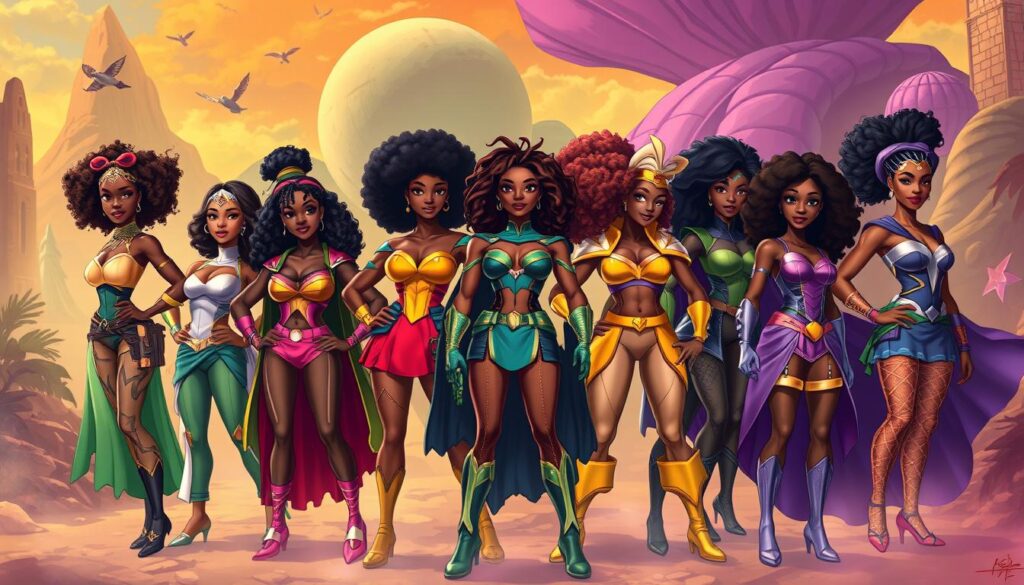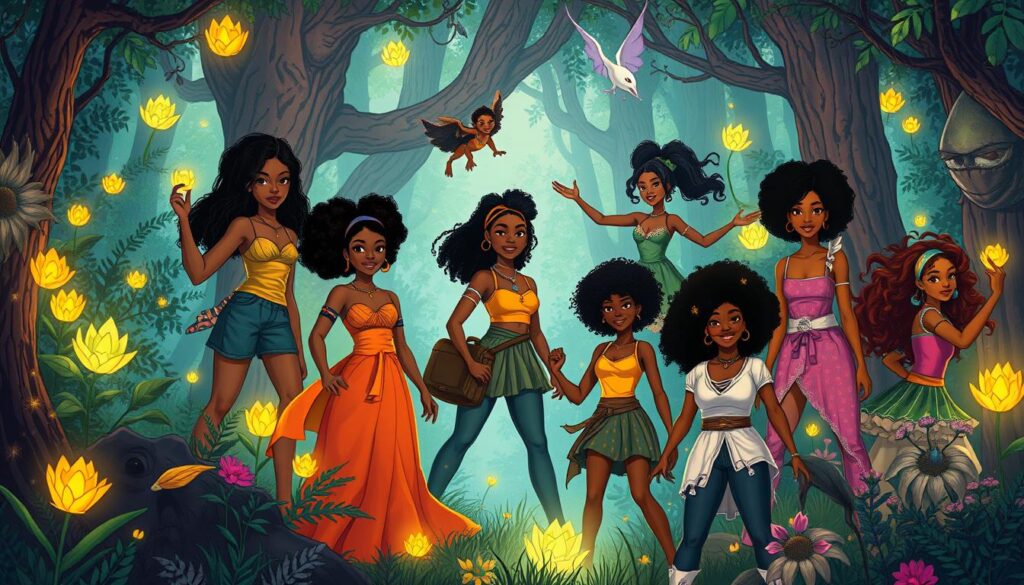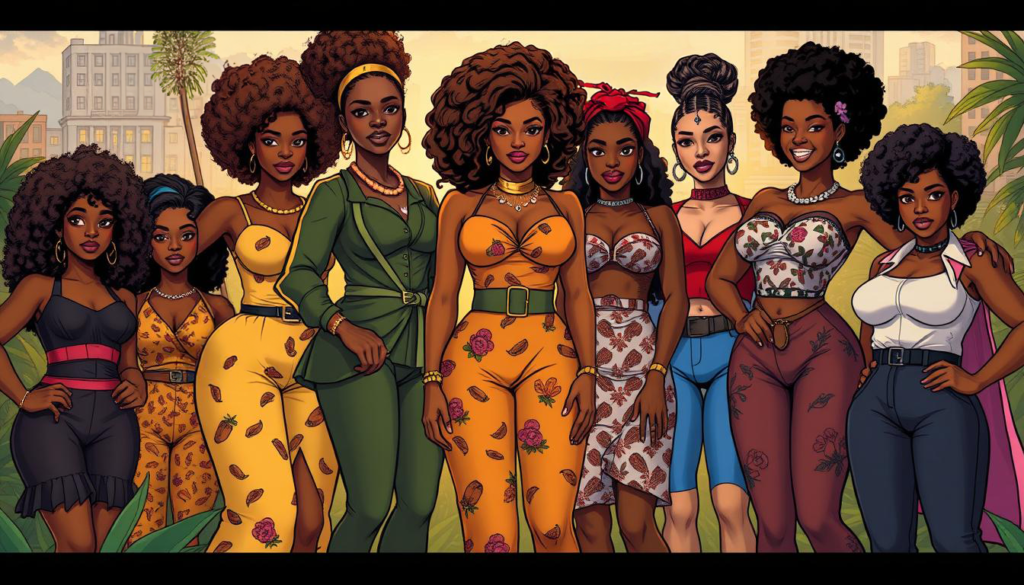
There’s a growing movement to showcase black heroines in fiction. This trend challenges the lack of diverse representation in literature. It highlights strong female protagonists from diverse backgrounds.
The Big Five publishers mainly publish books by white authors. However, stories featuring black heroines are gaining recognition. These narratives empower readers and provide inspirational role models.
Groundbreaking classics like Toni Morrison’s “Beloved” paved the way for this movement. Contemporary masterpieces such as Jesmyn Ward’s “Sing, Unburied, Sing” continue the tradition. These stories explore complex issues of race, class, and poverty.
By celebrating these characters and their creators, we challenge stereotypes. We promote empathy and understanding among readers. These stories can inspire real-life heroism and activism.
Our literature should mirror society’s diverse experiences and identities. Books with Black heroines promote cultural authenticity and challenge stereotypes. They empower young readers and showcase a variety of perspectives.
The publishing industry lags behind in reflecting U.S. diversity. In 2019, 71% of children’s books focused on White children or non-human characters. This lack of representation can isolate readers who don’t see themselves in stories.
BIPOC individuals under 15 now outnumber Whites in the U.S. However, the book industry hasn’t caught up. This gap affects how young readers view themselves and others.
Books with Black heroines offer nuanced portrayals of Black women and girls. They celebrate diverse experiences, achievements, and resilience. These stories counter negative or limited coverage of diverse backgrounds in literature.
By showcasing the Black experience accurately, these books foster equality and inclusion. They help readers understand different perspectives and cultures better.
| Year | Percentage of Children’s Books Featuring BIPOC Protagonists |
|---|---|
| 2018 | 1% |
| 2019 | 4% |
The table shows BIPOC protagonists are underrepresented in children’s books. There’s a slight increase from 2018 to 2019. However, the numbers remain low, highlighting the need for more diverse stories.
Representation matters in both storytelling and story selection. Black heroines as protagonists provide young readers with inspiring role models. These characters face challenges and triumph, boosting readers’ self-esteem and sense of belonging.
“When children cannot find themselves reflected in the books they read, or when the images they see are distorted, negative, or laughable, they learn a powerful lesson about how they are devalued in the society of which they are a part.” – Rudine Sims Bishop
Intersectional storytelling explores multiple identities shaping individual experiences. It paints a fuller picture of the Black experience. These stories foster empathy and understanding among readers.
Literary pioneers like Toni Morrison and Zora Neale Hurston paved the way for diverse voices. Their works sparked conversations about race, identity, and social justice. Promoting books with Black heroines ensures their legacy inspires future generations.
Classic literature features remarkable Black female protagonists who’ve shaped the literary world. These characters have challenged societal norms and inspired readers. Their stories showcase resilience and strength in the face of adversity.

Two novels stand out for their powerful Black female leads. Zora Neale Hurston’s “Their Eyes Were Watching God” (free book) and Toni Morrison’s “Beloved” are cornerstones of African American literature. Both works showcase complex and deep central characters.
Published in 1937, this novel introduces Janie Crawford’s journey of self-discovery. Hurston explores themes of love, identity, and the quest for autonomy. Janie fights against society’s expectations for Black women.
Her story is one of resilience and defiance. Janie learns to embrace her own desires and dreams. Hurston highlights the challenges faced by Black women in the early 20th century.
This Pulitzer Prize-winning novel tells Sethe’s haunting story. Set after the Civil War, it explores the trauma of slavery. Sethe confronts her past while trying to build a future.
Morrison’s powerful prose makes “Beloved” groundbreaking. The novel addresses slavery’s horrors and its lasting impact. It also highlights Sethe’s resilience and humanity in the face of unimaginable hardship.
| Novel | Author | Year Published | Protagonist |
|---|---|---|---|
| “Their Eyes Were Watching God” | Zora Neale Hurston | 1937 | Janie Crawford |
| “Beloved” | Toni Morrison | 1987 | Sethe |
Disclaimer: This article contains affiliate links. That means that I am awarded a small commission for purchases made through them, at no added cost for you.
These novels have left a lasting impact on literature. They challenge readers to confront racism and oppression. The stories celebrate the human spirit and the power of resilience.
Hurston and Morrison give voice to Black women’s experiences. Their work paves the way for future generations of writers and readers.
Strong Black female characters are now more common in children’s and young adult books. These stories inspire readers and provide needed representation. They cover various topics, from celebrating Black beauty to tackling social issues.

Picture books can shape young minds and teach positive values early on. Some great examples feature inspiring Black female main characters.
Older children look for more complex stories that match their experiences. Books with Black female leads are now more popular. They deal with important themes like racism, identity, and social justice.
| Book Title | Author | Year Published | Average Rating |
|---|---|---|---|
| Children of Blood and Bone | Tomi Adeyemi | 2018 | 4.11 (232,113 ratings) |
| The Hate U Give | Angie Thomas | 2017 | 4.49 (549,584 ratings) |
| One Crazy Summer | Rita Williams-Garcia | 2010 | 4.10 (27,570 ratings) |
| Brown Girl Dreaming | Jacqueline Woodson | 2014 | 4.26 (49,293 ratings) |
These novels both entertain and teach readers about young Black girls’ experiences. They show relatable and strong characters. This helps readers embrace their identities and stand up for what’s right.
“The Hate U Give” by Angie Thomas has been praised for its powerful portrayal of a young Black girl navigating the aftermath of witnessing a police shooting. The novel has sparked important conversations about systemic racism and social justice.
More stories with Black heroines are expected in children’s and young adult fiction. These books offer needed representation. They also help create a more understanding society.
Contemporary authors are reshaping modern literature with unforgettable characters and thought-provoking narratives. Talented black female writers showcase the depth and resilience of black women. They offer readers a window into diverse experiences and perspectives.
Yaa Gyasi’s debut novel “Homegoing” earned her the National Book Foundation’s “5 under 35” honors. Her epic follows two half-sisters born in Ghana and their descendants. Gyasi’s vivid writing illuminates slavery’s impact and family bonds’ strength.
Reni Eddo-Lodge’s “Why I’m No Longer Talking to White People About Race” has won multiple awards. Her work explores structural racism and its societal effects. Eddo-Lodge’s writing challenges readers to confront uncomfortable truths.
Tomi Adeyemi’s “Children of Blood and Bone” became a New York Times No. 1 bestseller. It captivates readers with its richly imagined world and fierce heroine. Angie Thomas’ “The Hate U Give” tackles police brutality through its protagonist, Starr Carter.
“We’ve been broken, but we have never forgotten. We are masters of the secrets we swallowed. The bits of ourselves we had to cut off to survive.” – Yaa Gyasi, Homegoing.
These authors are transforming the publishing industry. They’re breaking barriers despite limited representation in children’s books. Their work carves out space for diverse voices and stories.
Black female authors create characters that resonate with readers. They achieve literary excellence and promote inclusivity in publishing. Their stories inspire, challenge, and transform readers one page at a time.
Black heroines in literature have a lasting impact on readers and society. These powerful characters promote empathy, understanding, and real-life activism. They inspire readers to challenge stereotypes and fight against injustice.

Black heroines in fiction foster empathy and understanding among readers. By immersing in these characters’ lives, readers gain appreciation for Black women’s challenges and triumphs. This can lead to greater compassion and a more inclusive worldview.
Books like “The Color Purple” and “Beloved” feature complex Black female protagonists. These novels help readers understand the Black experience, especially struggles faced by Black women. By promoting empathy, these heroines contribute to the fight against racism.
Black heroines in fiction often inspire real-life heroism and activism. Readers witness their bravery and commitment to justice, motivating them to take action. This can include standing up against discrimination or supporting racial equality organizations.
| Book Title | Author | Real-Life Impact |
|---|---|---|
| The Hate U Give | Angie Thomas | Sparked conversations about police brutality and racial injustice |
| Hidden Figures | Margot Lee Shetterly | Highlighted the contributions of Black women in STEM fields |
| Becoming | Michelle Obama | Inspired readers to pursue their dreams and overcome adversity |
These heroines significantly impact young readers, who may see themselves reflected in these characters. They provide positive role models and showcase the power of resilience. Black heroines can help shape a generation of young activists committed to creating equality.
“The power of literature lies in its ability to transform lives and inspire change. Black heroines in fiction serve as beacons of hope, reminding us that even in the face of adversity, we have the strength within us to rise up and make a difference.“
Celebrating Black women’s voices in literature is crucial for societal impact. These characters entertain and serve as catalysts for empathy and activism. By embracing these stories, we can build a more compassionate world.
Black heroines in fiction challenge stereotypes and provide uplifting narratives. These stories celebrate the strength and complexity of Black women and girls. From classic to contemporary characters, they offer diverse reading experiences for all.
The impact of Black heroines goes beyond books. They inspire real-life heroism, activism, and empathy. These characters encourage readers to confront prejudices and foster understanding.
Supporting Black female authors amplifies their voices and characters. This contributes to the ongoing fight for equality and social justice. Embracing diverse reading ensures a rich literary landscape for future generations.
Let’s honor Black heroines who’ve touched our hearts and minds. We can look forward to more inspiring stories yet to come. Together, we can create a more inclusive literary world.
